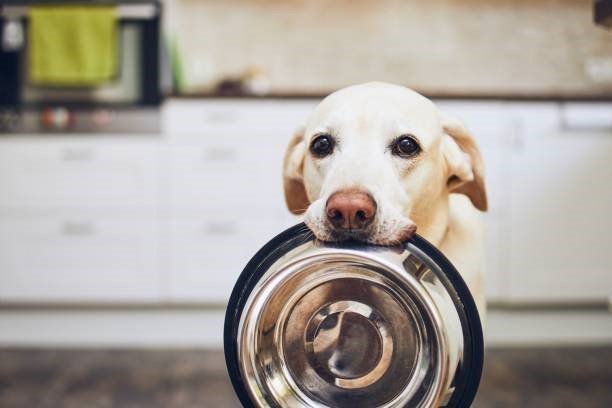Choosing the Right Food for Your Labrador: Top Nutritional Tips
Labradors are energetic, lovable companions that require proper nutrition to maintain their health and vitality. Understanding their unique dietary needs is crucial for their overall well-being and longevity.
Research shows that Feeding raw meat diet (RMD) is associated with factors such as dog breed, neuter status, and younger age, and owners perceive health benefits from this diet for their dogs.
Understanding Labrador Nutritional Requirements
Labradors have specific nutritional needs due to their size, activity level, and genetic predisposition to weight gain. Adult Labradors typically require between 1,500 and 2,200 calories daily, depending on their age, size, and activity level.
Protein is essential for maintaining your Labrador's muscle mass and energy levels. Look for foods containing 23-25% protein from quality sources like chicken, fish, or lamb. This ensures your Lab gets the amino acids needed for optimal health.
Healthy fats should make up 12-15% of your Lab's diet, providing essential fatty acids for coat health and energy. Omega-3 and omega-6 fatty acids are particularly important for maintaining joint health and reducing inflammation.
How Does a Labrador's Diet Change Throughout Their Life?
Puppy Stage (0-12 months)
Your Labrador puppy needs more calories and protein to support rapid growth and development. Choose puppy-specific formulas that contain DHA for brain development and balanced calcium levels for proper bone growth.
Adult Stage (1-7 years)
Adult Labs require balanced nutrition with moderate protein and controlled fat content to prevent weight gain. Select foods formulated specifically for large breeds to support joint health and maintain ideal body condition.
Senior Stage (7+ years)
Older Labradors benefit from lower-calorie diets with added glucosamine and chondroitin for joint support. Include foods with higher fiber content to aid digestion and maintain healthy weight.
How Can I Prevent My Labrador from Becoming Overweight?

Establishing proper portion control is crucial for preventing obesity in Labradors. Divide daily food portions into two meals, serving them at consistent times each day. Use measuring cups rather than estimating portions to ensure accurate feeding amounts.
Monitor your Lab's body condition regularly and adjust portions based on activity level and weight changes. A healthy Labrador should have a visible waist when viewed from above and palpable ribs without excess fat coverage.
Best Commercial Food Options
When selecting commercial dog food for your Labrador, consider these top recommendations based on nutritional value and quality:
• Premium Dry Kibble: Look for options with real meat as the first ingredient
• Grain-Inclusive Formulas: Unless your Lab has specific allergies
• Large Breed Specific Foods: Designed for proper joint support
• Limited Ingredient Diets: For Labs with food sensitivities.
Common Food Allergies and Sensitivities

Labradors can develop food sensitivities to common ingredients like chicken, beef, or grains. Watch for signs such as excessive scratching, digestive issues, or ear infections, which might indicate a food allergy.
If you suspect food allergies, consider transitioning to a limited-ingredient diet or consulting with your veterinarian for an elimination diet trial to identify the problematic ingredients.
Should I Consider Homemade Food for My Labrador?
While commercial dog foods offer convenience and balanced nutrition, some Lab owners opt for homemade diets. If choosing this route, consult with a veterinary nutritionist to ensure all essential nutrients are included in proper proportions.
Remember that homemade diets require careful planning and preparation to meet all nutritional requirements. Consider factors like ingredient availability, preparation time, and storage requirements before making this choice.
How Do I Know if My Lab's Current Diet is Working?
Regular monitoring of your Labrador's health indicators can help determine if their diet is appropriate. Look for signs like consistent energy levels, healthy coat condition, and proper weight maintenance.
Keep track of your Lab's weight and body condition score monthly. A healthy diet should result in regular bowel movements, clear eyes, and good dental health.
Frequently Asked Questions
How much should I feed my adult Labrador daily?
Adult Labradors typically need 2-3 cups of high-quality dry food per day, divided into two meals.
Can Labradors eat grain-free food?
While grain-free options are available, they are not necessary unless your Lab has specific grain allergies. Recent studies suggest grain-inclusive diets may be healthier for most dogs.
How often should I feed my Labrador puppy?
Puppies under six months should eat 3-4 small meals daily, transitioning to twice-daily feeding after six months.
Conclusion
Selecting the right food for your Labrador involves understanding their nutritional needs, considering their life stage, and monitoring their response to different diets. Focus on high-quality ingredients, proper portion control, and consistent feeding schedules to maintain your Lab's optimal health and happiness.
Remember to transition to new foods gradually and always consult with your veterinarian before making significant changes to your Labrador's diet, especially if they have specific health concerns or dietary restrictions.









Comments